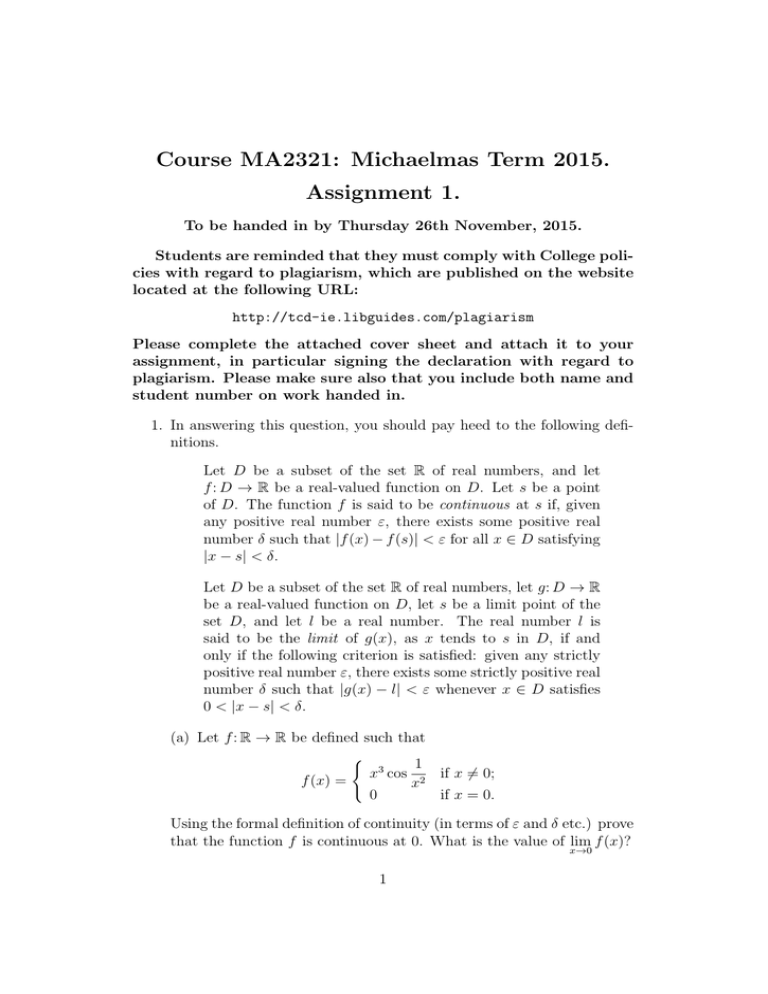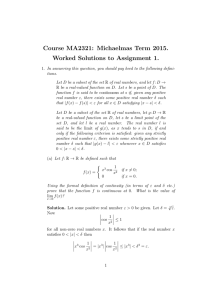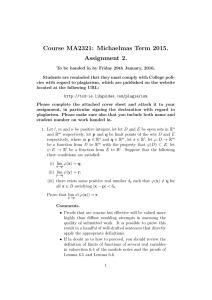Course MA2321: Michaelmas Term 2015. Assignment 1.
advertisement

Course MA2321: Michaelmas Term 2015. Assignment 1. To be handed in by Thursday 26th November, 2015. Students are reminded that they must comply with College policies with regard to plagiarism, which are published on the website located at the following URL: http://tcd-ie.libguides.com/plagiarism Please complete the attached cover sheet and attach it to your assignment, in particular signing the declaration with regard to plagiarism. Please make sure also that you include both name and student number on work handed in. 1. In answering this question, you should pay heed to the following definitions. Let D be a subset of the set R of real numbers, and let f : D → R be a real-valued function on D. Let s be a point of D. The function f is said to be continuous at s if, given any positive real number ε, there exists some positive real number δ such that |f (x) − f (s)| < ε for all x ∈ D satisfying |x − s| < δ. Let D be a subset of the set R of real numbers, let g: D → R be a real-valued function on D, let s be a limit point of the set D, and let l be a real number. The real number l is said to be the limit of g(x), as x tends to s in D, if and only if the following criterion is satisfied: given any strictly positive real number ε, there exists some strictly positive real number δ such that |g(x) − l| < ε whenever x ∈ D satisfies 0 < |x − s| < δ. (a) Let f : R → R be defined such that ( 1 x3 cos 2 if x 6= 0; f (x) = x 0 if x = 0. Using the formal definition of continuity (in terms of ε and δ etc.) prove that the function f is continuous at 0. What is the value of lim f (x)? x→0 1 (b) Let g: R → R be defined such that 0 if y = 6 0; g(y) = 1 if y = 0. Explain why the limit lim g(y) exists. What is the value of lim g(y)? y→0 y→0 (c) Let f : R → R and g: R → R be the functions defined in parts (a) and (b) of this question. Determine whether or not it is the case that lim g(f (x)) = l, x→0 where l = lim g(y). y→0 2. In this question, we employ partial derivatives, in the context of a real valued function f : R2 → R of two real variables. We also make use of the concept of the limit of such a function at a point of the plane R2 . Here are the definitions of the partial derivatives of the function f :— f (x + h, y) − f (x, y) ∂f (x, y) = lim , h→0 ∂x h ∂f (x, y) f (x, y + k) − f (x, y) = lim . k→0 ∂y k Let D be a subset of R2 . A point (u, v) of R2 is said to be a limit point of D if, given any strictly positive real number δ, there exist points (x, y) of D that are distinct from (u, v) but lie within a distance δ of (u, v). The definition of the limit of a function f of two variables may be formally stated as follows: Let D be a subset of R2 , let (u, v) be a limit point of the set D, let f : D → R be a real-valued function on D, and let l be a real number. Then l is said to be the limit of f (x, y), as (x, y) tends to (u, v) in D if, given any strictly positive real number ε, there exists some strictly positive real number δ such that |f (x, y) − f (u, v)| < ε for all (x, y) ∈ D satisfying p 0 < (x − u)2 + (y − v)2 < δ Moreover a function f of two real variables is continuous at a point (u, v) in the interior of its domain if and only if lim f (x, y) = f (u, v). (x,y)→(u,v) 2 Throughout the remainder of this question, let 2x2 y 3 if (x, y) 6= (0, 0); f (x, y) = x4 + y 6 0 if (x, y) = (0, 0). Note that a certain amount of information about this function could be obtained using various software packages, or else by typing the following query z = (2 x^2 y^3) / (x^4 + y^6) into the search bar on the following website: http://www.wolframalpha.com/ In particular, the above website will inform you that −4x5 y 3 + 4xy 9 ∂f (x, y) = , ∂x (x4 + y 6 )2 ∂f (x, y) 6x2 y 2 (x4 − y 6 ) = ∂y (x4 + y 6 )2 when (x, y) 6= (0, 0). Given any real numbers b and c, we define g(b,c) : R → R to be the function from the set R of real numbers to itself defined such that g(b,c) (t) = f (tb, tc) for all real numbers t, where the function f is as defined above. (a) Prove that −1 ≤ f (x, y) ≤ 1 for all real numbers x and y. Prove also that f (x, y) = 1 if and only if (x, y) 6= (0, 0) and x2 = y 3 , and also that f (x, y) = −1 if and only if (x, y) 6= (0, 0) and x2 = −y 3 . (b) For each ordered pair (b, c) of real numbers, show that the associated function g(b,c) is differentiable, and determine the value of the derivative dg(b,c) (t) dt for all values of the real variable t, including t = 0. (c) Show that the partial derivatives ∂f (x, y) , ∂x ∂f (x, y) ∂y are defined when (x, y) = (0, 0), and determine the value of these partial derivatives at (x, y) = (0, 0). 3 (d) Given any real number u, what are the supremum (i.e., the least upper bound) and infimum (i.e., the greatest lower bound) on the values of f (x, y) on the line x = u? (e) Given any real number v, what are the supremum and infimum values of the f (x, y) on the line y = v? (f) Is the function f continuous at (0, 0)? [Justify your answer rigorously using an ε–δ definition of either limits of functions of two real variables or else of continuity for functions of two real variables.] 4 Module MA2321—Analysis in Several Real Variables. Assignment I Name (please print): . . . . . . . . . . . . . . . . . . . . . . . . . . . . . . . . . . Student number: . . . . . . . . . . . . . . . . . . . . . . . . . . . . . . . . . . Date submitted: . . . . . . . . . . . . . . . . . . . . . . . . . . . . . . . . . . I have read and I understand the plagiarism provisions in the General Regulations of the University Calendar for the current year, found at http://www.tcd.ie/calendar I have also completed the Online Tutorial on avoiding plagiarism Ready Steady Write, located at http://tcd-ie.libguides.com/plagiarism/ready-steady-write Signed: .................................. 5









